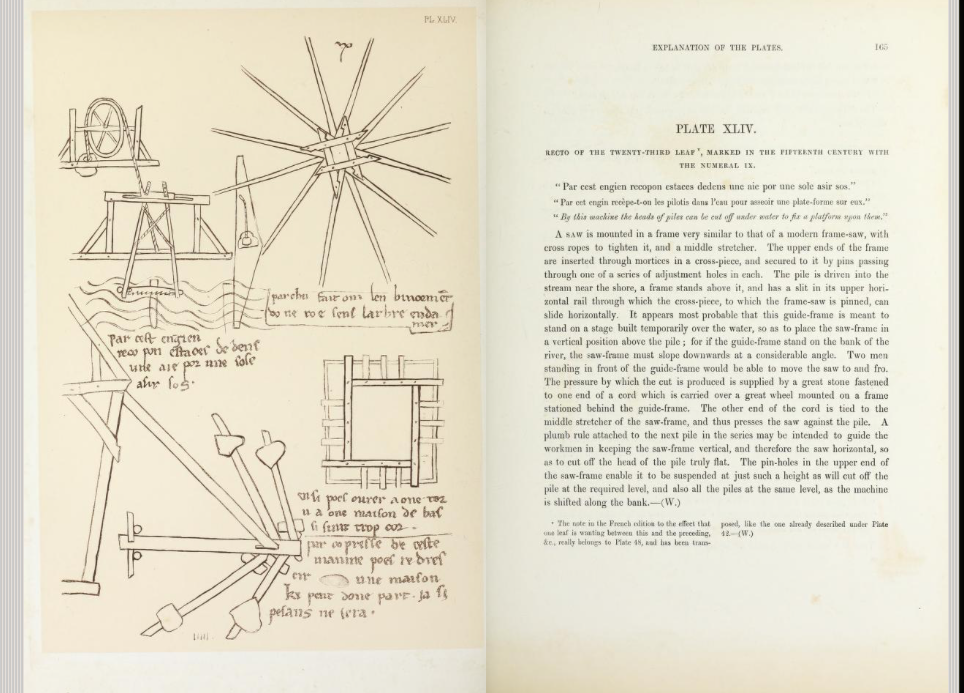|
Only two graphic documents survive to tell us about architectural design in the Romanesque period of church architecture: the 9th-century plan for the monastic complex at St.-Gall and the 13th-century sketchbook/portfolio of Villard de Honnecourt. The sketchbook comprises 33 leaves in various bound booklets gathered together in a leather binding. Villard left about 250 drawings of architecture, sculpture, nature, and technology along with comments about almost all of them. The portfolio describes what Villard saw but offers us very little description of Villard himself. A facsimile of a study of the Sketchbook is available at: https://archive.org/details/facsimileofsketc00vill/mode/2up 21 verso Fortune sits at the center of six spokes, the world at her feet as she turns the wheel. On her right, three figures ascend toward power, imagining themselves destined to be sovereign, powerful, enthroned, seated above Fortune, having conquered her. On Fortune’s left, three figures fall from grace, dragged under and around the wheel feet first, useless scepter in hand, eventually crumpling as the figure is ground under the wheel. Seven figures, but only Fortune is anchored. When the secular wheel of fortune blooms into a cathedral rose window with petal-lobes around an oculus, then, for purposes of faith, Fortune may be replaced by Christ, who is also set for the rising and falling of many. 22 verso and 23 recto Dreams of spires touching the sky and canyon- like naves and vaults that arch like the bowl of the Genesis firmament were pipe dreams until the incarnation of mechanics and technology that allowed for the music and poetry of cathedrals. A frame saw for cutting stone. A saw that saws by itself. A guide to attach spokes to a wheel a wheel that uses a system of pulleys to raise stone high in the air. Stone fulcrum and lever to raise a sleeper beam until the lever has reached its highest potential whereupon it is wedged up, the fulcrum relocated, and the process begins again. It was not enough to create temples in the imagination. Instead, imagine the cathedral, then innovate until stone and wood became levers and fulcrums and scaffolding and wheels that could create stone walls and wooden trussed roofs and round windows. Without pulleys there would be no clerestories. But there would be neither pulleys nor clerestories without the intention to build to the glory of God. 27 verso and 29 recto In worship, clergy and choir sit, kneel, stand for prayer and chant each in a separate seat, a choir stall. Side by side, habit by habit, a row -- maybe rows -- of duplicate vestments making indistinguishable people, separated from the congregation by the end of the row of stalls. How much is that separation worth to you? Villard first sketched Une legiere poupee :easily made: facile, in fact. An end for a row of stalls outwardly curved wood with a swirl of leaves. A tiny capital at the top beneath a multilayered cornice. Simple. Easy to make. Easy to separate Two leaves later and simple has become une bone poupee. A poppit – stall end – that is bone, that is, bonne. Not just good, but :as good as possible: Mirroring spirals swirl out -- no regard for straight wood grain. Covered in leaves, the two swirls touch and spring out: a fountain of leaves with branches. Villard directs: "Si vus volez bien ovrer dune bone poupee a uns estaus a cesti vus tenes." :If you have occasion to make an excellent poppit for stalls, take this design: Pay no mind to the cost in money or in labour. Separation between clergy and congregation is worth any cost. 31 verso Variations on a theme: hoops or circles over two Gothic lancets From the outside buttresses -- too close to see them fly -- from the inside blind arcade three arches. Proportions are key -- How much lancet? What size circle? How many columns? What is too narrow? 1:3 was golden: height to width. Divine. 32 verso It is as if they stand -- three stalwarts -- backs entirely straight feet shoulder-width apart heads up eyes forward one arm extended touching the shoulder of the one standing nearest fingertips barely touching that one’s shoulder in order to keep adequate and constant distance between them. And, actually, it isn’t ‘as if’. That is what they are doing. Lynn Miller Lynn Miller is a candidate for the MFA in Creative Writing at Mississippi University for Women. Her education and employment live at the intersection of art, faith, and education. She has served at various times in her life as a museum educator, a pastor, a freelance artist, and an art educator.
1 Comment
Carl Kinsky
9/6/2022 05:20:41 pm
This reminds me of my undergraduate thesis (using that term very loosely) 34 years ago about Villard de Honnecourt. I pronounced his name "Honeycourt" until a prof corrected me. Thanks for the time travel and the wonderful poems.
Reply
Your comment will be posted after it is approved.
Leave a Reply. |
The Ekphrastic Review
COOKIES/PRIVACY
This site uses cookies to deliver your best navigation experience this time and next. Continuing here means you consent to cookies. Thank you. Join us on Facebook:
July 2024
|










